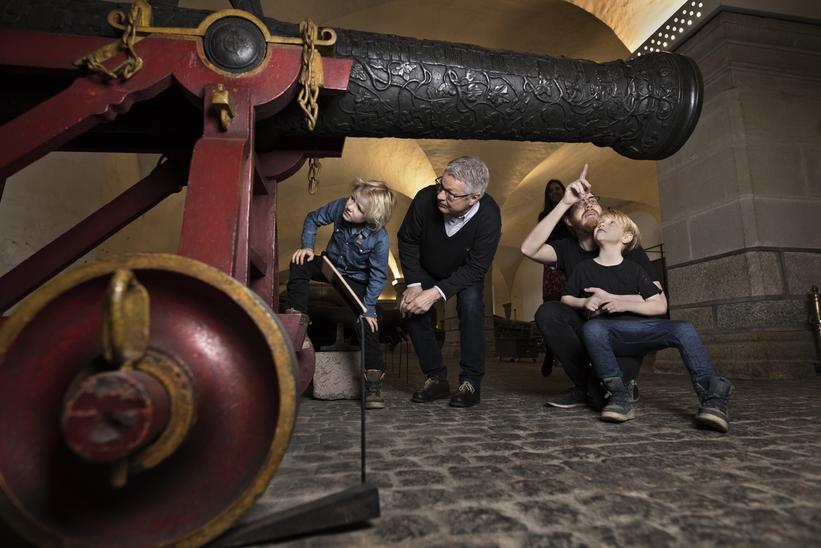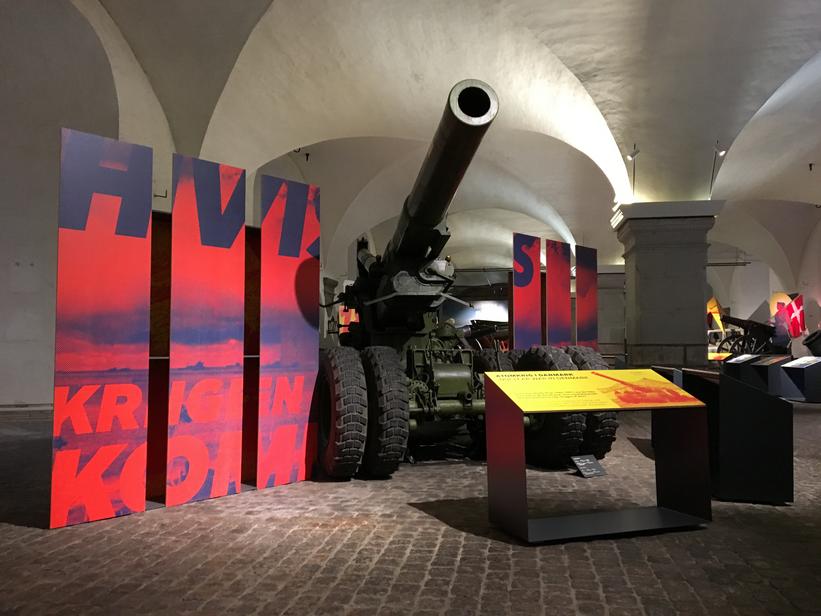
The king's old Arsenal Hall
The impressive 156-metre-long Arsenal Hall, with its high vaulted ceilings in Christian IV’s old Arsenal, has housed cannons ever since the year 1604.
Today, the Arsenal Hall is home to everything from Christian IV’s massive cannon weight from 1614 to more modern weapons such as DEHAWK missiles, howitzers and drones from Iraq.
You can also check out the unique Anholt cannons, which are the oldest preserved cannons in Denmark. The cannons, found off the island of Anholt, date back to the 15th century and may have been part of Margrethe I’s fleet.
The Arsenal Hall also invites visitors to delve deeper into eight fascinating stories about warfare:
Nuclear War in Denmark
During the Cold War, the looming threat of nuclear catastrophe was a part of everyday life for the citizens of Denmark. Danish soldiers therefore also underwent training in the use of nuclear weapons in the event of the Cold War heating up.
The Arsenal Hall features a 203mm howitzer from the Cold War era which can fire nuclear grenades.
The Great Defeat
The cannonballs rained down without mercy on the Danes at the Battle of Dybbøl in 1864. The Danes lost the battle against Prussia the predecessor to modern-day Germany. Since then, there have been many myths associated with the Danish defeat in the Second Schleswig War, which has had a major impact on how Danes perceive themselves even today.
You can find a cannon from each side of the Battle of Dybbøl and learn more about some of the reasons why Denmark suffered such a disastrous defeat.
The Battle of Heligoland Bight
Denmark gained a victory in the Second Schleswig War with theBattle of Heligoland Bight. The naval battle included the frigate JYLLAND on the Danish side, which was pitted against the Austrian frigates. The Danes emerged victorious as the Austrian ships eventually fled.
One of the cannons from the frigate JYLLAND is also featured in the Arsenal Hall.
Women and Cannons
In 1882, headmistress Louise Fenger started a collection among Danish women. The money was intended
to support the newly established fortifications of Copenhagen against attacks from Germany.
The women raised enough money to buy eight cannons, which were nicknamed the women’s cannons.
One of them is on display in the Arsenal Hall.
The Splendour of War and the Power of Love
King Frederick IV travelled to Italy where he fell in love with Maria Trenta. Unfortunately, she became a nun, and thus their romance was not to be. Instead, he received some very elegant and unique gilded Venetian cannons when he left Italy.
These gorgeous and ornate cannons are on display at the Arsenal Hall.
Faster, Longer, Deadlier
The evolution of cannons had remained at a standstill for 300 years. Around the end of the 19th century, however, new innovations began to accelerate. Today, cannons continue to evolve with small adjustments that create considerable advantages.
At the Arsenal Hall, you can study the evolution of cannons from the Middle Ages up to present day; from the 15th century rear-loaded cannons to DEHAWK missiles from 1964.
Three Ways to Shoot
Why, how and when do you use a cannon, howitzer or a mortar, and what is the difference between then?
You can find out at the Arsenal Hall.
Among the many artefacts on display is a mortar dating back to 1696 and a howitzer from 1772.
Every Man's Weapon
The use of drones has become more common in the armed forces and for civilian purposes.
In 2017-2018, Denmark’s elite special operations Jaeger Corps were deployed to western Iraq, where one of their tasks was to train the Ali al Furat Brigade. While training the Brigade, one of the vehicles was hit by a 40mm grenade from a modified hobby drone.
The Toyota pickup is on display in the Arsenal Hall, still featuring the damages caused by the drone. Fortunately, no one was killed in the blast.
